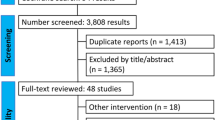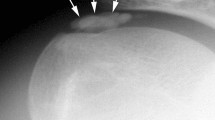Abstract
Purpose
We evaluated possible association of decreased psoas muscle area (PMA) after endovascular aneurysm repair (EVAR) by measuring the area of muscle in computed tomographic (CT) images.
Materials and Methods
We retrospectively reviewed CT images of 201 consecutive patients who underwent EVAR at our institution between April 1, 2015, and November 9, 2018, and compared them with images of 75 consecutive patients with no history of EVAR, who served as controls and underwent thoracic endovascular aortic repair (TEVAR) during the same period. We investigated EVAR and possible associated factors that might be potential predictors of decrease in PMA.
Results
Those patients with a history of EVAR demonstrated significantly greater mean decrease in PMA than those with a history of TEVAR after the repair procedure (mean 6.25% (8.5); P < 0.001; odds ratio [OR], 3.63; 95% confidence interval [CI] 1.90–6.90).
Conclusion
Although EVAR is a less stressful procedure than other major abdominal surgeries, we identified it as an independent predictor of decreased area of the psoas muscle. Thus, our results might encourage post-procedural evaluation of frailty associated with psoas muscle function and prescription of appropriate rehabilitation interventions after EVAR to help prevent deterioration of patients’ abilities.


Similar content being viewed by others
References
Kauppila LI. Atherosclerosis and disc degeneration/low-back pain–a systematic review. Eur J Vasc Endovasc Surg. 2019;37:661–70.
Honkanen T, Mäntysaari M, Leino T, et al. Cross-sectional area of the paraspinal muscles and its association with muscle strength among fighter pilots: a 5-year follow-up. BMC Musculoskelet Disord. 2019;20:170.
Womer AL, Brady JT, Kalisz K, et al. Do psoas muscle area and volume correlate with postoperative complications in patients undergoing rectal cancer resection? Am J Surg. 2018;215:503–6.
Hale AL, Twomey K, Ewing JA, et al. Impact of sarcopenia on long-term mortality following endovascular aneurysm repair. Vasc Med. 2016;21:217–22.
Cheng BT, Soult MC, Helenowski IB, et al. Sarcopenia predicts mortality and adverse outcomes after endovascular aneurysm repair and can be used to risk stratify patients. J Vasc Surg. 2019;70:1576–84.
Newton DH, Kim C, Lee N, Wolfe L. Sarcopenia predicts poor long-term survival in patients undergoing endovascular aortic aneurysm repair. J Vasc Surg. 2018;67:453–9.
Thurston B, Pena GN, Howell S, et al. Low total psoas area as scored in the clinic setting independently predicts midterm mortality after endovascular aneurysm repair in male patients. J Vasc Surg. 2018;67:460–7.
Fillinger MF, Greenberg RK, McKinsey JF, et al. Reporting standards for thoracic endovascular aortic repair (TEVAR). J Vasc Surg. 2010;52:1022–33.
Doros G, Lew R. Design based on intra-class correlation coefficients. Am J Biostat. 2010;1:1–8.
Kauppila LI. Can low-back pain be due to lumbar-artery disease? Lancet. 1995;346:888–9.
Koo TK, Li MY. A guideline of selecting and reporting intraclass correlation coefficients for reliability research. J Chiropr Med. 2016;15:155–63.
Kanda Y. Investigation of the freely available easy-to-use software 'EZR' for medical statistics. Bone Marrow Transpl. 2013;48:452–8.
Pillet J, Chevalier JM, Rasomanana D, et al. The principal artery of the psoas major muscle. Surg Radiol Anat. 1989;11:33–6.
Espahbodi S, Doré CJ, Humphries KN, et al. Color doppler ultrasonography of lumbar artery blood flow in patients with low back pain. Spine (Phila Pa 1976). 2013;38:E230–E2306.
Edwards EA, LeMay M. Occlusion patterns and collaterals in artheriosclerosis of the lower aorta and iliac arteries. Surgery. 1955;38:950–63.
Bertrand M, Godet G, Fléron MH, et al. Lumbar muscle rhabdomyolysis after abdominal aortic surgery. Anesth Analg. 1997;85:11–5.
Cruz-Jentoft AJ, Baeyens JP, Bauer JM, et al. Sarcopenia: European consensus on definition and diagnosis: Report of the European Working Group on Sarcopenia in older people. Age Ageing. 2010;39:412–23.
Hanaoka M, Yasuno M, Ishiguro M, et al. Morphologic change of the psoas muscle as a surrogate marker of sarcopenia and predictor of complications after colorectal cancer surgery. Int J Colorectal Dis. 2017;32:847–56.
Ikeno Y, Koide Y, Abe N, et al. Impact of sarcopenia on the outcomes of elective total arch replacement in the elderly. Eur J Cardiothorac Surg. 2017;51:1135–41.
Harada K, Suzuki S, Ishii H, et al. Impact of skeletal muscle mass on long-term adverse cardiovascular outcomes in patients with chronic kidney disease. Am J Cardiol. 2017;119:1275–80.
Funding
This study was not supported by any funding.
Author information
Authors and Affiliations
Corresponding author
Ethics declarations
Conflict of interest
The authors declare that they have no conflict of interest.
Ethical Approval
This type of study does not require formal consent.
Informed Consent
The institutional review boards of the participating institutions approved this retrospective study and waived the need for documentation of informed consent. Informed consent was obtained in the form of opt-out on the Web site [Approval Number: 31-285(9784)].
Consent for Publication
This retrospective study does not require formal consent.
Additional information
Publisher's Note
Springer Nature remains neutral with regard to jurisdictional claims in published maps and institutional affiliations.
Rights and permissions
About this article
Cite this article
Ouchi, K., Oki, Y., Sakuma, T. et al. Risk of Psoas Muscle Atrophy After Endovascular Aneurysm Repair Assessed by Cross-Sectional Psoas Muscle Area. Cardiovasc Intervent Radiol 43, 981–986 (2020). https://doi.org/10.1007/s00270-020-02500-x
Received:
Accepted:
Published:
Issue Date:
DOI: https://doi.org/10.1007/s00270-020-02500-x




